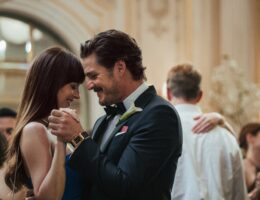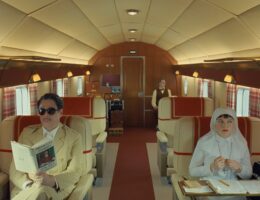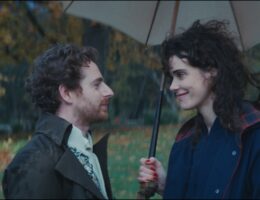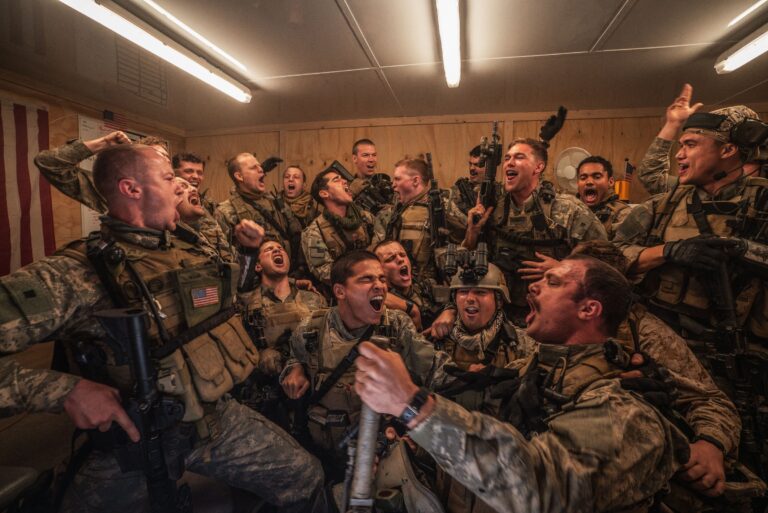Warfare (2025 | UK | 93 minutes | Ray Mendoza and Alex Garland)
After embedding audiences with fictional photojournalists covering a Civil War yet to come, director Alex Garland has teamed up with that film’s battle coordinator (himself a Navy SEAL veteran) Ray Mendoza to bring viewers into the heart of a 2006 surveillance mission gone sideways in Ramadi, Iraq. Constructed from the memories of the soldiers themselves, it’s an inarguably impressive feat of technical filmmaking, immersively told, and unfolding in nerve-rattlingly real-time. It’s stunningly effective, but a few days after seeing it, I’m not sure to what end.
The film’s only moment of frivolity is the almost-requisite A24 dance sequence. In this case, an opening shot of a dozen and a half of Young Hollywood’s hottest hunks portraying the real-life SEALs whose recollections shape the story. Key roles are played by D’Pharaoh Woon-A-Tai (as a Mendoza stand-in), Cosmo Jarvis (as the soldier to whom the film is dedicated), Will Poulter, Joseph Quinn, Kit Connor, and Charles Melton (who arrives late but makes a very strong impression). Vaguely interchangeable in their battle gear, one wonders how excluded the other twentysomething up-and-comers must’ve felt by not being invited to play soldiers. On the precipice of a big night out, they’re crowded shoulder-to-shoulder, filling every inch of their base’s rec room’s tight quarters. A small television showing the writhing aerobic dancers from the video for Swedish DJ Eric Prydz’s “Call On Me” inspires the boys to writhe along to the Steve Winwood “Valerie” sample, chopped into a club-friendly techno remix. It’s the biggest workout the theater’s sound system will get for a solid 30 minutes.
From there, the film descends into a minute-by-minute recreation of a night raid, all silent clipped communications of covert action. In this case, it’s taking over the apartment building from a couple of terrified Iraqi families, confining them to a bedroom, smashing up some walls, and silently waiting for something to happen. Aside from a few cuts to aerial surveillance, there’s little in the way of explanation as to the purpose of the mission, just a whole lot of waiting, abbreviated radio reporting back to unseen command, and watching the neighbors through a sniper’s scope. In his first outing as director of photography, David J. Thompson works within the confines of longtime Garland collaborator Mark Digby’s production design to communicate the sweaty, dusty, anxiety as mission details are conveyed in fragments up and down the chain of command in the cramped quarters.
For quite a while, nothing happens, until all of a sudden it does. By the time the requisitioned apartment finds itself taking on grenades and gunfire from “insurgents”, we haven’t really gotten to know the soldiers in any traditional way. There’s a hierarchy and networks of friendships, the translator/scouts on the outside, and the little-seen civilians cowering in a bedroom. As the explosions break the relative silence (Glenn Freemantle’s sound design is sure to be “in the conversation“), the action shifts to self-preservation and increasingly complicated retreat.
Visceral and harrowing at every turn, the ensuing gunfights, bombing, and resulting carnage display a level of reverent verisimilitude enhanced by the presence of several of its subjects on set. “Shows of force” by military jet flybys rattle our ears as if we’re there. Ratting firefights and the explosion from IEDs confront audiences with the literal fog of war. Mangled bodies, pulverized limbs, and the screams of soldiers suffering from trauma crowd the screen, conveying the pressing mortal urgency of their retreat. The gunfights are breathtaking, the arrival of reinforcements nerve-wracking, and the screams of the severely injured sickening. Throughout, the impressive cast acquits themselves with military precision.
As strikingly potent as all of these scenes are, Garland and Mendoza seem steadfastly averse to anything resembling character development, let alone editorializing. The closest thing their film comes to this is toward the end when an unnamed character screams “WHY?!?”. Indeed, that’s the question about the Iraq War, isn’t it? Maybe at this point in our history, decades later, anyone not already haunted by that question never will be.
I struggle with whether the mode of storytelling, all action, studiously disinterest in the context of why (or really even who) is a smug provocation of avoidance or a challenge to the audience to do their own research. One might charitably imagine that the supreme focus on depicting a terrible thing, in the way the event happened, with as much authenticity as one can convey on a set built in the outskirts of London, could be Garland’s attempt to challenge the François Truffaut-attributed assertion that there’s no such thing as an anti-war film. It certainly uses its mode of storytelling to avoid lionizing the conflict or its outcomes.
But to believe this is to ignore the obvious fact that the reality of the events is informed entirely by the collective memories of a very specific group of people who survived to leave the hellish experience in Bradley tanks (and to the exclusion of many others who did not). It’s also a challenge of a film with two credited directors whose impulses and intentions might not be entirely aligned, one of whom is a combat veteran whose experiences, along with those of his fellow soldiers directly inform and motivate many of the choices. Through their first-hand experiences, these men contributed to the story, contributed to the actors’ training, were on set, and some even appear in the film’s coda. Their triumphal group snapshot with the cast at the culmination of their filmmaking mission is a queasy echo of the grotesque closing shot of Civil War. What they did together in making this film no doubt functioned as a kind of therapy and an undeniable bonding experience. The work is laudably accomplished and is a standout theatrical experience; I’m just not sure that I have the appetite for it.
Warfare arrives in theaters on April 11
Photo credit Murray Close, courtesy A24




